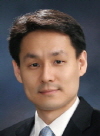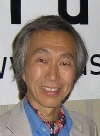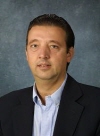 |
|
|
|
| |
 |
|
| |
 |
 Plenary Talk I - October 17(WED), 2012 (15:15~16:15) Plenary Talk I - October 17(WED), 2012 (15:15~16:15) |
 Prof. Kyu-Jin Cho Prof. Kyu-Jin Cho
(Biorobotics Laboratory, School of Mechanical and Aerospace Engineering, Seoul National University / Korea)
|
 |
 Soft Robotics: A New Approach to Bio-Inspired Robotics Soft Robotics: A New Approach to Bio-Inspired Robotics |
 Abstract: Soft robotics is an emerging field of research that uses soft or compliant
materials and elements to overcome the limitation of traditional robotics. Traditionally, robots have been used in an industrial environment with few unknown parameters. As more and more robots are
used to interact with environments that are uncertain and vulnerable to change, a technology that can easily adapt to
the changing environment is needed. Soft robotics deals with this issue by using soft and compliant elements in an
intelligent way. Bio-inspired robotics is the field of robotics that leads the use of this technology. In this talk,
I will give an overview of various soft bio-inspired robotic technologies and some of the robots that are being
developed at SNU Biorobotics Laboratory. These soft robotic technologies will be helpful for robots that need
to perform in rough or uncertain environments such as military robots and biomedical robots. Abstract: Soft robotics is an emerging field of research that uses soft or compliant
materials and elements to overcome the limitation of traditional robotics. Traditionally, robots have been used in an industrial environment with few unknown parameters. As more and more robots are
used to interact with environments that are uncertain and vulnerable to change, a technology that can easily adapt to
the changing environment is needed. Soft robotics deals with this issue by using soft and compliant elements in an
intelligent way. Bio-inspired robotics is the field of robotics that leads the use of this technology. In this talk,
I will give an overview of various soft bio-inspired robotic technologies and some of the robots that are being
developed at SNU Biorobotics Laboratory. These soft robotic technologies will be helpful for robots that need
to perform in rough or uncertain environments such as military robots and biomedical robots.
|
|
 |
 Plenary Talk Ⅱ - October 18(THU), 2012 (10:45~11:45) Plenary Talk Ⅱ - October 18(THU), 2012 (10:45~11:45) |
 Prof. William Singhose Prof. William Singhose
(Department of Mechanical Engineering, Georgia Institute of Technology / U.S.A.)
|
 |
 Improving Human Operation of Oscillatory Dynamic Systems Improving Human Operation of Oscillatory Dynamic Systems
|
 Abstract:
Humans are very good at operating a wide variety of machines such as bicycles, cars, and computers. However, when the system being controlled has lightly-damped, low-frequency oscillatory dynamics, it is difficult to control the machine behavior and drive it to a desired state. This presentation examines the manual control of systems with such problematic oscillatory dynamics. The problem is illustrated using simple 1-dimensional tracking tasks, as well as multi-dimensional crane manipulation tasks. Tracking performance is then improved by using input shaping to suppress command-induced oscillation. Operator studies are presented that show tracking behavior using controlled elements with both low-frequency and high-frequency oscillatory modes. Measures of tracking performance and subjective task difficulty are reported, and frequency-domain control characteristics are discussed. These results demonstrate that input shaping can greatly improve the continuous tracking ability of human-machine systems that have oscillatory modes. Abstract:
Humans are very good at operating a wide variety of machines such as bicycles, cars, and computers. However, when the system being controlled has lightly-damped, low-frequency oscillatory dynamics, it is difficult to control the machine behavior and drive it to a desired state. This presentation examines the manual control of systems with such problematic oscillatory dynamics. The problem is illustrated using simple 1-dimensional tracking tasks, as well as multi-dimensional crane manipulation tasks. Tracking performance is then improved by using input shaping to suppress command-induced oscillation. Operator studies are presented that show tracking behavior using controlled elements with both low-frequency and high-frequency oscillatory modes. Measures of tracking performance and subjective task difficulty are reported, and frequency-domain control characteristics are discussed. These results demonstrate that input shaping can greatly improve the continuous tracking ability of human-machine systems that have oscillatory modes.
|
|
 |
 Plenary Talk Ⅲ - October 18(THU), 2012 (15:15~16:15) Plenary Talk Ⅲ - October 18(THU), 2012 (15:15~16:15) |
 Prof. Shin'ichi Yuta Prof. Shin'ichi Yuta
(Department of Electrical Engineering, Shibaura Institute of Technology
/ Japan)
|
 |
 Autonomous Navigation in Indoor/Outdoor Environments by Mobile Robots: Autonomous Navigation in Indoor/Outdoor Environments by Mobile Robots:
- Environment Sensing, Position Estimation, and Motion Control
|
 Abstract: One of the most important function of autonomous robots is the ability to work in the real usual environment. I have been researching on this theme based on the experimental and task oriented approach. Abstract: One of the most important function of autonomous robots is the ability to work in the real usual environment. I have been researching on this theme based on the experimental and task oriented approach.
In this lecture, I will show our experimental mobile robot platforms and several experiences of sensing environment, robot positioning, autonomous map making, and autonomous navigation in real in-door and out-door environments.
Also, I will mention an open experiment of autonomous travelling of 1 km+ in the city pedestrian by the mobile robots. This open experiment named “Tsukuba challenge” was conducted between 2007 and 2011. In 2011, almost 70 groups in the “Tsukuba challenge” participated from all over Japan. And six robots completed autonomous navigation of designated 1.4 km route which includes the urban pedestrian street, city plaza, and corridors of the mall.
|
|
 |
 Plenary Talk Ⅳ - October 19(FRI), 2012 (15:15~16:15) Plenary Talk Ⅳ - October 19(FRI), 2012 (15:15~16:15) |
 Prof. Stratos Pistikopoulos Prof. Stratos Pistikopoulos
(Department of Chemical Engineering, Imperial College London, United Kingdom)
|
 |
 Multi-Parametric Programming & Explicit Model Predictive Control Multi-Parametric Programming & Explicit Model Predictive Control
- a progress report |
 Abstract: Multi-Parametric programming provides a complete map of solutions of an optimization
problem as a function of, unknown but bounded, parameters in the model, in a computationally efficient manner, without exhaustively enumerating the entire parameter space. In a Model-based Predictive Control (MPC) framework, multi-parametric
programming can be used to obtain the governing control laws ? the optimal control variables as an explicit function of the state variables. The main advantage of this approach is that it reduces repetitive on-line control and optimization to
simple function evaluations, which can be implemented on simple computational hardware, such as a microchip, thereby opening avenues for many applications in chemical, energy, automotive, and biomedical equipment, devices and systems. Abstract: Multi-Parametric programming provides a complete map of solutions of an optimization
problem as a function of, unknown but bounded, parameters in the model, in a computationally efficient manner, without exhaustively enumerating the entire parameter space. In a Model-based Predictive Control (MPC) framework, multi-parametric
programming can be used to obtain the governing control laws ? the optimal control variables as an explicit function of the state variables. The main advantage of this approach is that it reduces repetitive on-line control and optimization to
simple function evaluations, which can be implemented on simple computational hardware, such as a microchip, thereby opening avenues for many applications in chemical, energy, automotive, and biomedical equipment, devices and systems.
In this presentation, we will first provide a historical overview of the key developments in multi-parametric programming and control. We will then describe a number of key application areas, where this technology shows a lot of potential and discuss key challenges and directions
for future research. We will critically address the question of the suitability of explicit/multi-parametric control as part of the advanced model-based control technology portfolio of the future.
|
|
|
|
|
|
